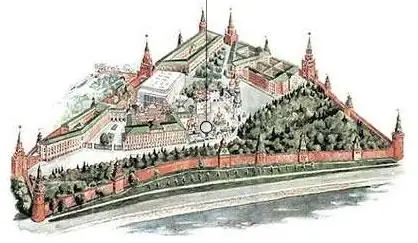- Author Harold Hamphrey [email protected].
- Public 2023-12-17 10:06.
- Last modified 2025-01-24 11:10.
This sunny and hospitable southern city is located on the banks of the mighty Don. Many interesting monuments of history, culture and architecture are carefully stored here, which illustrate the difficult history of the city. It is impossible to find out in one or two days. Perhaps a week is not enough to get acquainted with all the city's attractions. But today we will visit only one of them - Theater Square in Rostov.

Some historical facts
Back in the 19th century, on the very spot where today the most beautiful square of the city is located, there was an abandoned wasteland. Rostov-on-Don was located on one side of it, and Nakhichevan-on-Don on the other. In 1913, an interesting Art Nouveau building appeared on the wasteland - the Office of the Vladikavkaz Railway.

In the late 20s and early 30s of the last century, the square had a different name - the Revolution. Today, this is reminiscent of the preserved park, which is still called the Park of the Revolution. It was laid out in 1927 by the agronomist G. N. Zamnius. The park covers a huge areain 21 hectares.
The theater building was built in the lowlands of the Revolution Park, in the constructivist style, which was widespread in architecture in the 20s. After the completion of the theater, the appearance of the square began to take shape. Previously, in its northwestern part, there were buildings of the Nikolaev hospital, which was built on voluntary donations from the townspeople. Its project was developed by the Rostov architect N. M. Sokolov.
On the south side of Theater Square in Rostov, a residential five-story building of railway workers appeared. During the war, the theater building was badly damaged. For its restoration in the city, almost immediately after the victory in the war, a competition was announced. After the complete liberation of the city from the Nazis (1943), a city rally was held on Theater Square in Rostov. Its participants decided to erect a monument to the fallen soldiers-liberators here.

In 1981, the Atomkotlomash high-rise building was erected on the square. Around the same time, a new building of the Medical Institute (now the Medical University) was built on the western side of the square, and the construction of the Theater Spusk began, consisting of a cascade of multi-storey residential buildings that descend to the Don.
On the southwestern border of the square during the years of perestroika, a residential building was built using the latest technologies and architectural achievements. All buildings located on the square have architectural features typical of their time.
Teatralnaya square in Rostov today
On the square are the Directorate of the North Caucasus Railway,Drama Theatre. M. Gorky, offices of well-known companies. The decoration of the square was the Memorial dedicated to the soldiers-liberators.
Memorial
The history of the creation of the memorial, which is located on the Theater Square in Rostov-on-Don and is the hallmark of the city, began in 1953. The Union of Architects of the city announced a competition for the creation of a monument dedicated to the victorious soldiers. The work of Rostov sculptor R. Sheker and architect N. Sokolov won a convincing victory. They proposed to build a stele with a red star framed by a laurel wreath at the top and a colonnade behind the stele.
Unfortunately, the city authorities did not have money for the construction of this facility. The project, as they said, was temporarily mothballed, but, to the surprise of the authors, another competition was announced in 1959, this time at the all-Union level. It was attended by four very strong creative teams, including Moscow ones. And again the victory was won by the Rostovites - the sculptor R. G. Sheker, the architects A. R. Pyupke and N. P. Sokolova. They offered a 37-meter figure of a Red Army soldier saluting from a machine gun. A green square was planned next to the monument.
The creation of the Eternal Flame was out of the question at that time, since this element began to be used later, when gasification spread widely throughout the country. Again, there were no funds for the project. At that time, the drama theater had not yet been restored, and all the money went to this construction site.
And only in 1983 the monument, which was dreamed of after the war, took its place of honor in Rostov on Theater Square (photoyou can see below). This is a 72-meter-high stele, with a gilded sculpture of the Greek goddess Nike, who is dressed in a cape. The memorial was solemnly opened on the Theater Square of Rostov on the eve of Victory Day 1983.

Fountains
Next to the drama theater on the Theater Square in Rostov is a complex of fountains. A young sculptor, a graduate of the Rostov Art College Evgeny Vuchetich, became the author of the main one. The composition is represented by four Atlanteans holding a dome in their hands. A square pool located in the center on a pedestal with a sculptural group of Atlanteans holding a flat bowl with jets of water spouting upwards - this is exactly what Vuchetich's fountain looks like.

According to urban legend, while carrying out this project, the young sculptor settled scores with city officials, giving the features of their faces to the muzzles of amphibians at the feet of the Atlanteans.
Rostov, Theater Square: how to get there?
This is the main square of the city, so it will not be difficult to find it. Buses No. 1, 2, 3, 7, 9, 22, as well as fixed-route taxis go to Theater Square in Rostov from the Main Railway Station. From the airport you can take bus number 7, trolleybus number 9.






